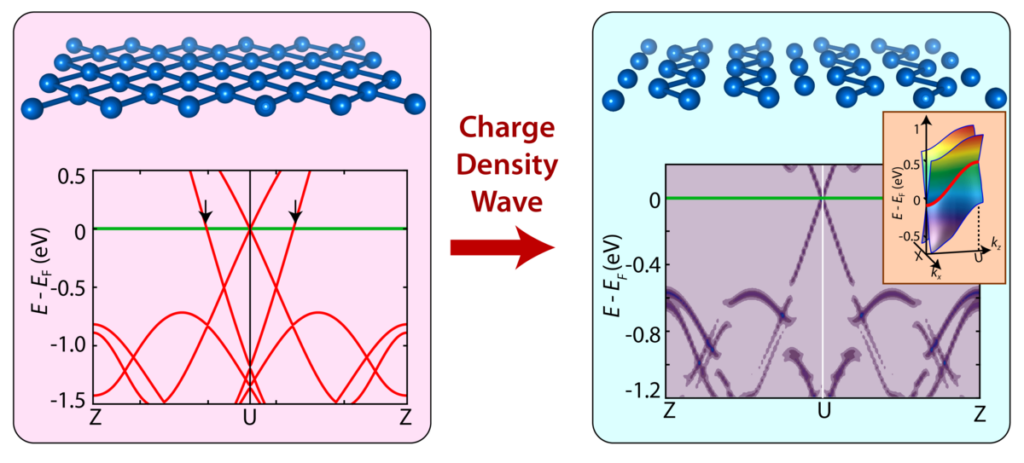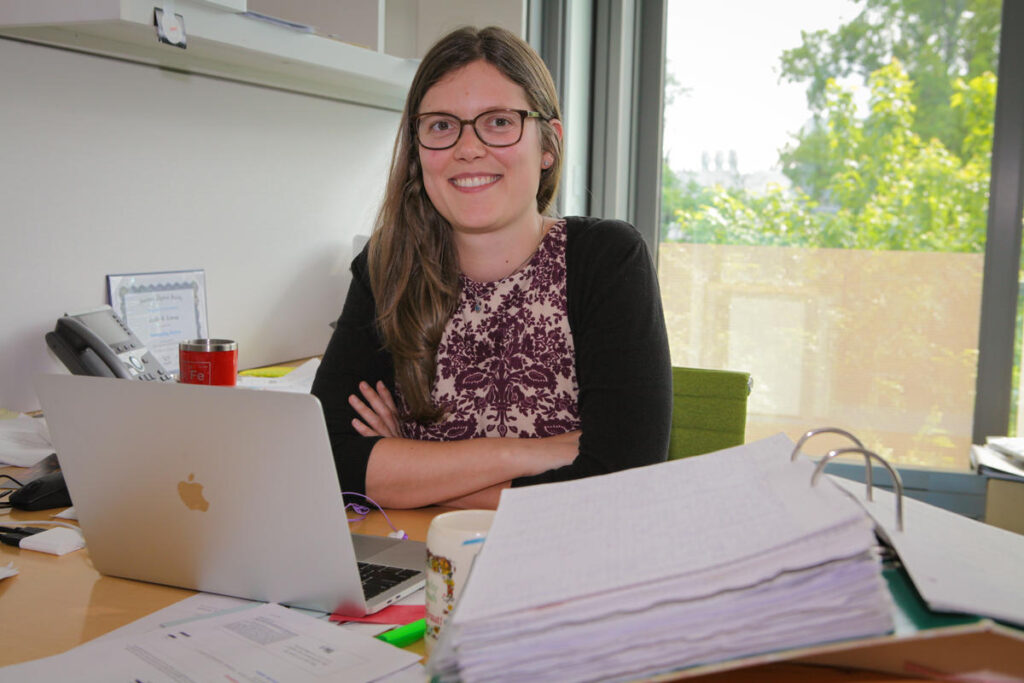Schoop lab designs, probes new Dirac semimetal
In research that draws on expertise from both chemistry and physics to deepen our understanding of the properties of topological matter, the Department of Chemistry’s Schoop Lab introduces a mechanism to design an idealized Dirac semimetal of a new kind.
The new strategy designs clean nonsymmorphic Dirac semimetals, allowing researchers to uncover electronic behaviors that had been theorized but not previously demonstrated because of interfering states or “noise” surrounding the preferred electronic state.
A nonsymmorphic semimetal uses a special kind of symmetry – nonsymmorphic – to realize exotic electronic behavior. However, it is possible to probe this electronic behavior if just the electronic states of interest, and no others, are contributing to electron movement under an applied current.
Researchers were able to probe these properties by designing a new material using the proposed mechanism, which relies on crystal structure distortion or charge density waves, to filter out extraneous states.

A charge density wave is utilized as a tool to engineer an idealized Dirac semimetal. The charge density wave gaps all bands at the Fermi level except the symmetry-protected Dirac nodal line.
In addition, researchers demonstrate that the designed compound GdSb0.46Te1.48 exhibits a highly unusual electronic behavior that doesn’t match any known models. Thus, the new design mechanism might lead to the discovery of a materials class with electronic behavior that is different from known electronic material types such as semimetals, semiconductors, or insulators.
These topological materials are presently not well-studied experimentally because of their non-ideal band structures. The lab’s proposed mechanism gets around that problem by suppressing up to 95% of the interfering bands.
“This problem has always fascinated me,” said Assistant Professor of Chemistry Leslie Schoop. “These materials were first predicted back in 2012. And then in 2016, as a postdoc, I realized the prediction partially but not perfectly. It has been bothering me ever since: it’s a novel state of electronic matter and it needed realization, right? That’s what I do as a material chemist – somebody predicts some novel kind of state of matter, and I’m going to try to make it happen in a compound.
“When I made it happen during my postdoc, the electronic structure was so messy that we couldn’t probe the nonsymmorphic state’s behavior if a current was applied. Five years later, we’ve figured out how to get rid of the mess.”
Researchers achieved the results through a mechanism that uses chemical substitutions to minimally distort the symmetry of the material’s crystal lattice in order to drive away the “states that annoy us.”

Assistant Professor of Chemistry Leslie Schoop.
“It’s a beautiful trick and I’m really happy about it,” Schoop added. “These new states are protected by the nonsymmorphic symmetry element. We just need to keep this symmetry alive and then we can play tricks that we know from chemistry to make everything else go away.”
The paper, Band Engineering of Dirac Semimetals Using Charge Density Waves, was recently published in Advanced Materials. The highly collaborative work drew on the contributions of theorists, experimentalists, and those with expertise in electronic transport, including researchers from Princeton University’s Department of Physics.
Researchers began their investigation with a known material that has a perfect square structure in the crystal lattice. The material exhibited many interesting electrical states – too many, however, to observe the ones they most wanted to see. By chemically modifying the lattice structure, they forced a distortion in the symmetry in just one direction. The distortion drove away 95% of the obscuring states.
“Previously, the strategy to discover new Dirac materials mainly relied on exhaustive materials searches from the known materials database,” said Shiming Lei, former postdoc in the Schoop lab and now a research scientist at Rice University, and lead author on the paper. “The material structure and phases we are interested in have continuous evolution of charge density waves that cannot be readily found in that material database.
“Guided by the chemical intuition, we synthesized a series of crystals with controlled chemical composition and demonstrated that the period of charge density wave modulation is indeed continuously modulated,” Lei added. “Importantly, the irrelevant electronic states show significant reduction, and a very clean Dirac band crossing near the Fermi level is retained.”
Applications for this mechanism are “a bit far-fetched right now,” said Schoop. Nevertheless, she is hopeful that the lab’s mechanism, proved in this one example, can be tested and utilized with other materials as a way to expand on our fundamental understanding of topological matter.
“The fascinating thing is that the electronic properties show details that puzzle us – it looks like it’s really a new behavior in electronics,” Schoop added. “Our observed properties didn’t fit any of these previous models, so that means whatever happens in our system must be something new.
“We hope there will be follow-up publications on this by people who can shed light on the origin of these electronic unusual properties.”
Funding for this research was supported by the Arnold and Mabel Beckman Foundation through a Beckman Young Investigator grant awarded to L.M.S. The authors acknowledge the use of Princeton’s Imaging and Analysis Center (IAC), which is partially supported by the Princeton Center for Complex Materials (PCCM), a National Science Foundation (NSF) Materials Research Science and Engineering Center (MRSEC; DMR- 2011750).
